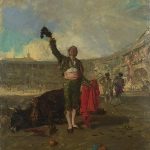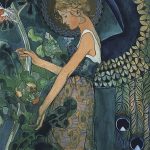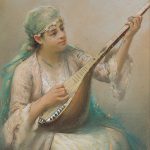Adam Styka, born on April 7, 1890, in Kielce, Poland, was an artist whose vibrant and dynamic paintings captured the essence and spirit of Orientalist themes, desert landscapes, and the Bedouin way of life. Coming from a family deeply rooted in artistic pursuits, Adam was the son of the renowned Polish painter, Jan Styka, famous for his monumental work. This environment nurtured Adam’s early interest and dedication to art, leading him to study at the prestigious École des Beaux-Arts in Paris, France, where he honed his skills and developed his distinctive style.
Adam Styka’s journey as an artist was marked by his deep fascination with North Africa and the Middle East. After his education, he embarked on numerous travels to Egypt, Algeria, and Morocco, among other places. These expeditions were not merely touristic; they were profound exploratory missions that allowed him to immerse himself in the cultures, landscapes, and lives of the people he encountered. This immersion was crucial, as Styka sought authenticity in his portrayal of Orientalist themes, striving to capture the essence of his subjects with empathy and respect.
Styka’s artwork is characterized by its vivid use of color, meticulous attention to detail, and the ability to convey the luminosity and warmth of the desert sun. His paintings often depicted scenes of daily life in the desert, majestic Arabian horses, colorful marketplaces, and serene oases, bringing to life the beauty and harshness of the desert environment. Through his art, Adam Styka played a significant role in the Orientalist movement, which, despite its complex legacy, contributed to a greater, albeit romanticized, understanding of Eastern cultures in the Western world.
Beyond his Orientalist works, Adam Styka also painted religious scenes, portraits, and landscapes, showcasing his versatility as an artist. His religious paintings, in particular, reflect a profound spirituality and a deep respect for his subjects, qualities likely inherited from his father, whose own work often explored similar themes.
Adam Styka’s contributions to the art world were recognized with numerous awards and accolades throughout his career. His paintings were exhibited widely, both in Europe and the United States, garnering admiration and critical acclaim. Styka’s work found a passionate audience in the United States, where he eventually settled, continuing his artistic pursuits and cementing his legacy as a painter of note.
The artist’s personal life was as rich and colorful as his paintings. He married and had a family, and his descendants continue to honor his legacy, preserving his works and promoting their visibility to new generations of art enthusiasts. Adam Styka’s life was a testament to the power of art to transcend cultural and geographical boundaries, connecting people through the universal language of beauty and emotion.
Adam Styka passed away on September 23, 1954, in Doylestown, Pennsylvania, USA. His death marked the end of a prolific career that left an indelible mark on the art world. Today, his works are housed in numerous private collections and museums worldwide, including the National Museum in Warsaw, the Musée d’Orsay in Paris, and the Pennsylvania Academy of the Fine Arts in Philadelphia. These institutions, among others, serve as custodians of his artistic legacy, ensuring that Adam Styka’s vision and contributions to the world of art continue to inspire and captivate audiences for generations to come.
Reflecting on Adam Styka’s life and career, it is evident that his work was driven by a genuine passion for exploration, a deep appreciation for the cultures he depicted, and an unwavering commitment to artistic excellence. His paintings not only offer a window into the diverse landscapes and peoples he encountered but also serve as a bridge connecting different worlds through the universal appeal of art. In a world increasingly divided by cultural and ideological differences, Adam Styka’s legacy reminds us of the power of art to unite, to enlighten, and to enrich the human experience.
In conclusion, Adam Styka was more than just an artist; he was a cultural ambassador who, through his paintings, invited viewers to explore and appreciate the beauty and diversity of the world. His body of work stands as a vibrant testament to his skill, his vision, and his profound respect for the subjects he portrayed. As we continue to engage with Adam Styka’s art, we are reminded of the enduring power of creativity to bridge gaps, to communicate across cultures, and to celebrate the rich tapestry of human life.






